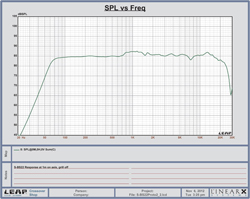Question:
I’m looking at the new Pioneer SP-BS22-LR bookshelf speakers for a 5.1 setup. These speakers are rated from 55Hz to 20kHz using a 4-inch driver. Can a 4-inch driver really deliver that kind of low-frequency performance?
Ganesh
New York, NY
Answer:
Surprisingly, it can. As you can see in Pioneer’s measurement results above, the speaker’s response at 55Hz is down by about 6dB compared with the nominal level throughout most of the frequency range, which is typical when specifying a speaker’s low-frequency response.
To achieve this response, the SP-BS22-LR’s enclosure is ported in the rear, which provides a controlled outlet for the sound waves emanating from the rear of the driver. This extends the bass response of the speaker compared with a sealed-box design, and according to the speaker’s designer, Andrew Jones, it results in a better mid-bass balance.
Another design element that extends the bass response of the speaker is the woofer’s vented pole piece. For those who might not know this term, the pole piece of any dynamic-speaker driver is a cylindrical object around which a coil of wire called the voice coil is wound. The pole-piece/voice-coil assembly is attached to the rear of the dust cap at the center of the diaphragm. As an audio signal flows through the voice coil, it creates an oscillating magnetic field that interacts with the static field of the permanent magnet that surrounds the voice coil, pushing it—and the attached diaphragm—back and forth, thus converting the electrical audio signal into acoustic sound waves. The pole piece is made of a material with high magnetic permeability and serves to focus the static magnetic field.
In the SP-BS22-LR, the pole piece is vented behind the dust cap, which lowers the nominal resonant frequency of the system and increases the mechanical Q factor, a measure of the losses at resonance—a higher Q factor means less loss and improved bass. Without venting, Jones says, the trapped air behind the dust cap impedes the diaphragm’s motion, reducing its efficiency and increasing its nominal resonant frequency as well as distortion.
Of course, as the frequency falls below 55Hz, the response of the speaker drops quickly, so you need a subwoofer to reproduce the lowest portion of the human hearing range. The THX-specified crossover at 80Hz is a good choice for this speaker, since you want the crossover frequency to be somewhat above the absolute bottom of the speaker’s response so there’s no sonic gap between the speaker and the sub.



